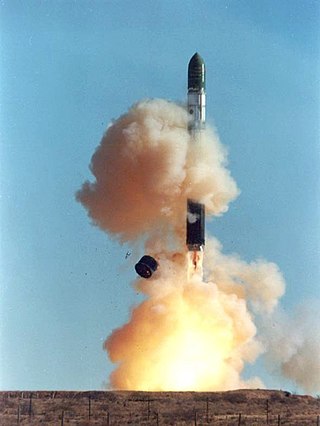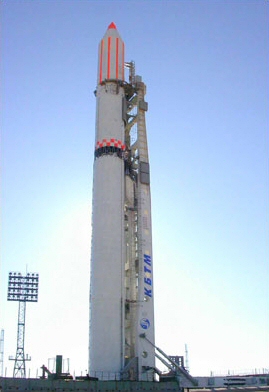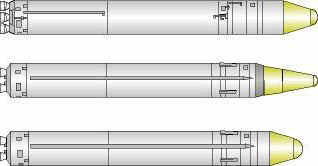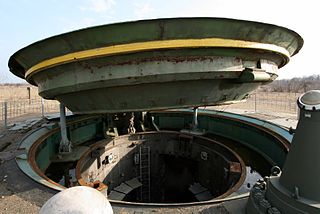
An intercontinental ballistic missile (ICBM) is a ballistic missile with a range greater than 5,500 kilometres (3,400 mi), primarily designed for nuclear weapons delivery. Conventional, chemical, and biological weapons can also be delivered with varying effectiveness, but have never been deployed on ICBMs. Most modern designs support Multiple Independently-targetable Reentry Vehicles (MIRVs), allowing a single missile to carry several warheads, each of which can strike a different target. Russia, the United States, China, France, India, the United Kingdom, Israel, and North Korea are the only countries known to have operational ICBMs.

In military terminology, a missile is a guided airborne ranged weapon capable of self-propelled flight usually by a jet engine or rocket motor. Missiles are thus also called guided missiles or guided rockets. Missiles have five system components: targeting, guidance system, flight system, engine and warhead. Missiles come in types adapted for different purposes: surface-to-surface and air-to-surface missiles, surface-to-air missiles, air-to-air missiles, and anti-satellite weapons.

The LGM-30 Minuteman is an American land-based intercontinental ballistic missile (ICBM) in service with the Air Force Global Strike Command. As of 2023, the LGM-30G Minuteman III version is the only land-based ICBM in service in the United States and represents the land leg of the U.S. nuclear triad, along with the Trident submarine-launched ballistic missile (SLBM) and nuclear weapons carried by long-range strategic bombers.
The SM-65 Atlas was the first operational intercontinental ballistic missile (ICBM) developed by the United States and the first member of the Atlas rocket family. It was built for the U.S. Air Force by the Convair Division of General Dynamics at an assembly plant located in Kearny Mesa, San Diego. Atlas became operational in October 1959, but was soon made obsolete as an ICBM by new development, and was retired from this role by 1965.

The Strategic Rocket Forces of the Russian Federation or the Strategic Missile Forces of the Russian Federation is a separate-troops branch of the Russian Armed Forces that controls Russia's land-based intercontinental ballistic missiles (ICBMs).

The RT-2PM2 «Topol-M» is one of the most recent intercontinental ballistic missiles to be deployed by Russia, and the first to be developed after the dissolution of the Soviet Union. It was developed from the RT-2PM Topol mobile intercontinental ballistic missile.

The R-36 is a family of intercontinental ballistic missiles (ICBMs) and space launch vehicles (Tsyklon) designed by the Soviet Union during the Cold War. The original R-36 was deployed under the GRAU index 8K67 and was given the NATO reporting name SS-9 Scarp. It was able to carry three warheads and was the first Soviet MRV missile. The later version, the R-36M was produced under the GRAU designations 15A14 and 15A18 and was given the NATO reporting name SS-18 Satan. This missile was viewed by certain United States analysts as giving the Soviet Union first strike advantage over the U.S., particularly because of its rapid silo-reload ability, very heavy throw weight and extremely large number of re-entry vehicles. Some versions of the R-36M were deployed with 10 warheads and up to 40 penetration aids and the missile's high throw-weight made it theoretically capable of carrying more warheads or penetration aids. Contemporary U.S. missiles, such as the Minuteman III, carried up to three warheads at most.

The RT-2PM Topol is a mobile intercontinental ballistic missile designed in the Soviet Union and in service with Russia's Strategic Missile Troops. As of 2014, Russia planned to replace all RT-2PM ICBMs with versions of Topol-M.

The RT-23 Molodets was a cold-launched, three-stage, solid-fueled intercontinental ballistic missile developed and produced before 1991 by the Yuzhnoye Design Bureau in Dnipro, Ukraine. It came in silo- and rail-based variants, and was armed with 10 MIRV warheads of 550 kt yield. All missiles were decommissioned by 2005 in accordance with the START II.

Pivdenmash, also known as Yuzhmash, meaning Southern Engineering, is a Ukrainian state-owned aerospace manufacturer. It was formerly a Soviet state-owned factory prior to 1991.

The R-9 was a two-stage IRBM of the Soviet Union, in service from 1964 to 1976.

The R-5 Pobeda was a theatre ballistic missile developed by the Soviet Union during the Cold War. The R-5M version was assigned the NATO reporting name SS-3 Shyster and carried the GRAU index 8K51.

The R-12 Dvina was a theatre ballistic missile developed and deployed by the Soviet Union during the Cold War. Its GRAU designation was 8K63, and it was given the NATO reporting name of SS-4 Sandal. The R-12 rocket provided the Soviet Union with the capability to attack targets at medium ranges with a megaton-class thermonuclear warhead and constituted the bulk of the Soviet offensive missile threat to Western Europe. Deployments of the R-12 missile in Cuba caused the Cuban Missile Crisis in 1962. A total of 2335 missiles were produced; all were destroyed in 1993 under the START II treaty.

The UR-100N, also known as RS-18A is an intercontinental ballistic missile in service with Soviet and Russian Strategic Missile Troops. The missile was given the NATO reporting name SS-19 Stiletto and carries the industry designation 15A30.

Start-1 is a Russian satellite launch vehicle based on the RT-2PM Topol, a Soviet intercontinental ballistic missile developed by Moscow Institute of Thermal Technology.

The RT-20P was an experimental intercontinental ballistic missile (ICBM) developed but not deployed by the Soviet Union during the Cold War. The control system for it was designed at NPO "Electropribor". It was assigned the NATO reporting name SS-15 Scrooge and carried the GRAU index 8K99. The RT-20 was the first mobile ICBM designed by the Soviet Union. Its launch platform was based on the T-10 tank.

The RS-24 Yars - modification 24) also known as RT-24 Yars or Topol'-MR is a Russian MIRV-equipped, thermonuclear armed intercontinental ballistic missile first tested on May 29, 2007, after a secret military R&D project.

A missile launch facility, also known as an underground missile silo, launch facility (LF), or nuclear silo, is a vertical cylindrical structure constructed underground, for the storage and launching of intercontinental ballistic missiles (ICBMs), intermediate-range ballistic missiles (IRBMs), medium-range ballistic missiles (MRBMs). Similar facilities can be used for anti-ballistic missiles (ABMs).
The RS-27 (?) or SS-X-32Zh (?) Barguzin BZhRK (БЖРК) Project is a rail-mobile intercontinental ballistic missile (ICBM) under development for the Russian RVSN, as a replacement of the previous railway missile train Molodets BZhRK SS-24 Scalpel. BZhRK stands for railway strategic missile train. The missile was expected to enter testing in 2019 and enter service in 2020.





















